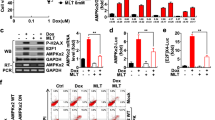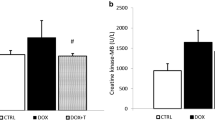Abstract
Anthracyclines, such as doxorubicin and daunorubicin, are highly effective anticancer agents. Cardiotoxicity made by these agents develops as a complication of the cancer chemotherapy. Melatonin, the chief secretory product of the pineal gland, was recently found to be a free radical scavenger and antioxidant. We decided to evaluate the tissue-protective effect of melatonin against myocardial toxic effects of doxorubicin in six groups of rats. Rats were given doxorubicin (Dx) (45 mg/kg dose) and melatonin (MEL) (10 mg/kg), first doxorubicin and then melatonin (DM), first melatonin and then doxorubicin (MD). The degree of cardiac muscle cell alterations were examined either histologically (mean total score technique) or biochemically. In doxorubicin-treated group, malondialdehyde (MDA) levels of the heart tissue were significantly increased, glutathione (GSH) levels were decreased compared to the control rats. In the group in which first doxorubicin and then melatonin was given, MDA levels were significantly decreased and glutathione (GSH) levels were increased compared to the doxorubicin-treated group. During ultrastructural analysis, in doxorubicin-treated group, cellular edema, mitochondrial deformation, decreased glycogen stores, and disordered myofibrillary structure were observed. In contrast, in first doxorubicin and then melatonin-treated group, normal cellular structure was observed. But, first melatonin and then doxorubicin-treated group was not significantly preserved from the doxorubicin-induced changes. By preventing lipid peroxidation and myocardial lesions, melatonin may be highly effective in protecting against doxorubicin-induced cardiotoxicity.
Similar content being viewed by others
References
Olson RD, Mushlin PS: Doxorubicin cardiotoxicity: analysis of prevailing hypotheses. FASEB J 4: 3076–3086, 1990
Rajagopalan S, Politi PM, Sinha BK, Myers E: Adriamycin-induced free radical formation in the perfused rat heart: implications for cardiotoxicity. Cancer Res 48 (17): 4766–4769, 1988
Lee V, Randhawa AK, Singal PK: Adriamycin-induced myocardial dysfunction in vitro is mediated by free radicals. Am J Physiol 261: H989–995, 1991
Sarvazyan NA, Askari A, Huang WH: Effects of doxorubicin on cardiomyocytes with reduced level of superoxide dismutase. Life Sci 57: 1003–1010, 1995
Singal PK, Siveski-Iliskovic N, Hill M, Thomas TP, Li T: Combination therapy with probucol prevents adriamycin-induced cardiomyopathy. J Mol Cell Cardiol 27: 1055–1063, 1995
Vora J, Khaw B A, Narula J, Boroujerdi M: Protective effect of butylated hydroxyanisole on adriamycin induced cardiotoxicty. J Pharm Pharmacol 48: 940–944, 1996
Reiter R, Tang L, Garcia JJ, Munoz-Hoyos A: Pharmalogical actions of melatonin in oxygen radical pathophysiology. Life Sci 60: 2255–2271, 1997
Neri B, de Leonardis V, Gemelli MT, di Loro F, Mottola A, Ponchietti R, Raugei A, Cini G: Melatonin as biological response modifier in cancer patients. Anticancer Res 18: 1329–1332, 1998
Poeggeler B, Reiter RJ, Tan DX, Chen LD, Manchester LC: Melatonin, hydroxy radical-mediated oxidative damage, and aging: A hypothesis. J Pineal Res 14: 151–168, 1993
Pieri C, Marra M, Moroni F, Recchioni R, Marcheselli F: Melatonin: A peroxyl radical scavenger more effective than vitamin E. Life Sci 55:PL 271–276, 1994
Gilad E, Cuzzocrea S, Zingarelli B, Salzman AL, Szabo C: Melatonin is a scavenger of peroxynitrite. Life Sci 60: PL 169–174, 1997
Li ZR, Reiter RJ, Fujimori O, Oh CS, Duan YP: Cataractogenesis and lipid peroxidation in newborn rats treated with buthionine sulfoximine: Preventive actions of melatonin. J Pineal Res 22 : 117–123, 1997
Bertuglia S, Marchiafava PL, Colantuoni A: Melatonin prevents ischemia reperfusion injury in hamster cheek pouch microcirculation. Cardiovasc Res 31: 947–952, 1996
Duncker DJ, Verdouw PD: Has melatonin a future as a cardioprotective agent? Cardiovasc Drugs Ther 15: 205–207, 2001
Sahna E, Parlakpı nar H, Özer MK, Öztürk F, Özuğurlu F, Acet A: Melatonin protects against myocardial doxorubicin toxicity in rats: Role of physiological concentrations. J Pineal Res 35: 257–261, 2003
Ahmed HH, Mannaa F, Elmegeed GA, Doss SH: Cardioprotective activity of melatonin and its novel synthesized derivates on doxorubicin-induced cardiotoxicity. Bioorg Med Chem 13: 1847–1857, 2005
Timlioğlu Ö, Kutsal Ş, Özkur M, Uluoğlu Ö, Arı cı oğlu A, Çevik C, Düzgün E, Sancak B, Poyraz A: The effect of EGb 761 on the doxorubicin cardiomyopathy. Res Commun Mol Pathol Pharmacol 106: 181–192, 1999
Akbulut KG, Gönül B, Akbulut H: Differential effects of pharmacological doses of melatonin on malondialdehyde and glutathione levels in young and old rats. Gerontology. 45: 67–71, 1999
Kurtel H, Granger D N, Tso P, Grisham MB: Vulnerability of intestinal interstitial fluid the oxidant stres. Am J Physiol 263: G573–578, 1992
Casini A, Ferrali M, Pompella A, Maellaro E, Comborti M: Lipid reroxidation and cellular damage in extrahepatic tissues of bromobenzene intoxicated mice. Am J Pathol 123: 520–531, 1986
Kozluca O, Olcay E, Sürücü S, Güran Z, Kulaksı z T, Üskent N: Prevention of doxorubicin induced cardiotoxicity by catechin. Cancer Lett 98: 1–6, 1995
Liu X, Chen Z, Chua CC, Ma YS, Youngberg GA, Hamdy R, Chua BH: Melatonin as an effective protector against doxorubicin-induced cardiotoxicity. Am J Physiol Heart Circ Physiol 283: H254–263, 2002
Agapito MT, Antolin Y, del Brio MT, Lopez-Burillo S, Pablos MI, Recio JM: Protective effect of melatonin against adriamycin toxicity in the rat. J Pineal Res 31: 23–30, 2001
Xu MF, Tang PL, Qian ZM, Ashraf M: Effects by doxorubicin on the myocardium are mediated by oxygen free radicals. Life Sci 68: 889–901, 2001
Doroshow JH, Locker GY, Myers CE: Enzymatic defenses of the mouse heart against reactive oxygen metabolites: alterations produced by doxorubicin. J Clin Invest 65: 128–135, 1980
Pieri C, Marra M, Moroni F, Recchioni R, Marcheselli F: Melatonin: a peroxyl radical scavenger more effective than vitamin E. Life Sci 55: PL 271–276, 1994
Hardeland R, Reiter RJ, Poeggeler B, Tan DX: The significance of the metabolism of the neurohormone melatonin: antioxidative protection and formation of bioactive substances. Neurosci Biobehav Rev 17: 347–357, 1993
Meister A: Glutathione deficiency produced by inhibition of it's synthesis and it's reversal : applications in research and therapy. Pharmacol Ther 51: 155–194, 1991
Dziegiel P, Murawska-Cialowicz E, Jethon Z, Januszewska L, Podhorska-Okolow M, Surowiak P, Zawadzki M, Rabczynski J, Zabel M: Melatonin stimulates the activity of protective antioxidative enzymes in myocardial cells of rats in the course of doxorubicin intoxication. J Pineal Res 35: 183–187, 2003
Wallace KB: Doxorubicin-induced cardiac mitochondrionopathy. Pharmacol Toxicol 93: 105–115, 2003
Author information
Authors and Affiliations
Corresponding author
Rights and permissions
About this article
Cite this article
Öz, E., Erbaş, D., Sürücü, H.S. et al. Prevention of doxorubicin-induced cardiotoxicity by melatonin. Mol Cell Biochem 282, 31–37 (2006). https://doi.org/10.1007/s11010-006-1153-9
Received:
Accepted:
Issue Date:
DOI: https://doi.org/10.1007/s11010-006-1153-9




